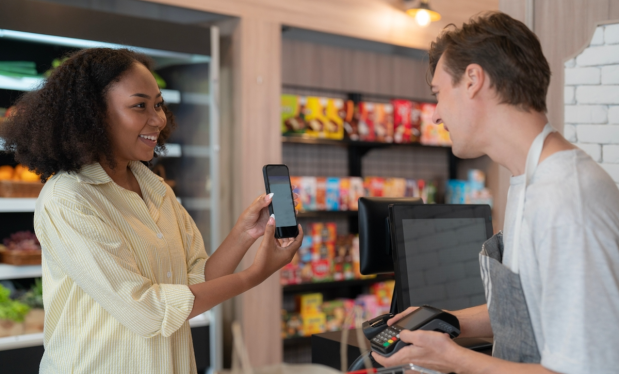Convenience Retail Giants Embrace Click-and-Mortar™ Tech to Bridge Digital-Physical Gap

As consumers increasingly engage across brick-and-mortar and digital channels, convenience retailers are integrating new technologies into the in-store experience.
According to a recent report from the National Association of Convenience Stores (NACS), nearly two-thirds of shoppers are members of retailers’ loyalty programs.
“Customers are using their phones to navigate your store; they are ordering ahead and coming into the store to pick up their order; they might even be in the store ordering food from their device. The list goes on,” the association’s vice chairman of research and technology Charlie McIlvaine commented at the NACS State of the Industry Summit.
Many consumers are merging their digital and physical retail journeys. The PYMNTS Intelligence study “2024 Global Digital Shopping Index: U.S. Edition,” created in collaboration with Visa Acceptance Solutions, drew from a survey of more than 2,400 United States consumers. It found that across retail, 31% of shoppers fall into the Click-and-Mortar™ category. Specifically, approximately 1 in 5 shops in stores with the assistance of digital technologies, and 11% make purchases digitally for in-store pickup.
Convenience stores are stepping up their use of technology to meet this demand. For instance, Casey’s General Stores shared on a call discussing its latest earnings report that membership in its rewards program reached more than 7.7 million, with the company driving adoption with targeted promotions.
Similarly, Circle K owner Alimentation Couche-Tard President and CEO Brian Hannasch noted on a call accompanying the convenience store firm’s last financial report that members “are visiting our locations more frequently and with a higher basket” than non-members, and the program is growing.
Meanwhile, convenience store giant 7-Eleven is stepping up its use of technology across the path to purchase. On the chain’s parent company 7 & I Holdings’ last earnings call, 7-Eleven, Inc. president Stan Reynolds noted that the store is “accelerating digital delivery, including 7REWARDS loyalty programs, digital programs, including mobile and self-checkout, 7NOW delivery, and our retail media network.”
He added that deal-chasing consumers are adopting the retailer’s loyalty program to get better value, driving growth in enrollment, and that the program’s members spend more in their average transaction than non-members and visits stores as much as 20 times more.
“Not only are customers seeking out loyalty programs, but their demand for delivery continues to grow,” Reynolds said. “Customers, even in the current economy, seek out delivery for their weekly routine.”
Many — but not most — consumers seek out the convenience of on-demand food delivery. Data from PYMNTS Intelligence’s study last year “Connected Dining: Third-Party Restaurant Aggregators Keep the Young and Affluent Engaged” found that 40% of consumers had used an aggregator at least once in the previous six months.
By offering on-demand delivery, c-stores can capture additional revenue, carving out new occasion. Offering online ordering and delivery services can attract new customers and encourage existing ones to make more frequent purchases, increasing overall sales and revenue.
Plus, omnichannel strategies can help convenience stores build stronger customer relationships and foster loyalty. By offering personalized promotions, recommendations, and rewards across different channels, convenience stores can incentivize customers to engage more frequently and spend more with their brand.

